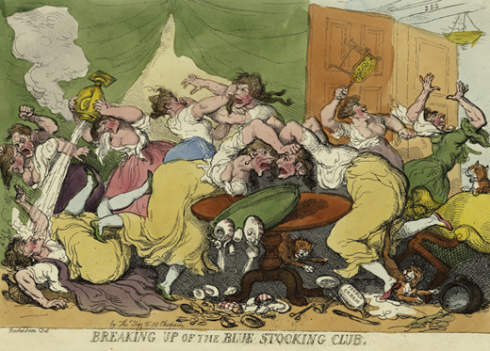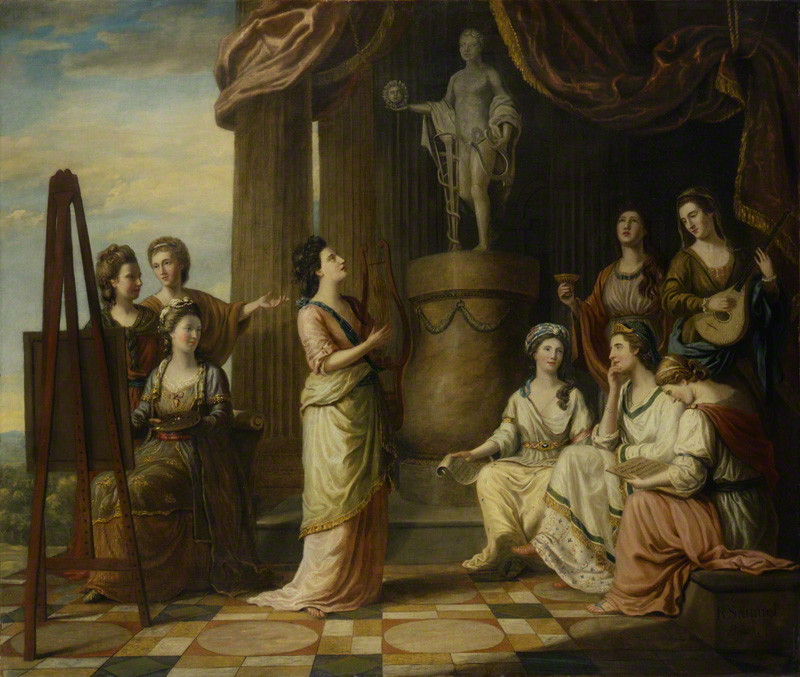In Regency times, would you have been a “bluestocking”? How many times have you read about (or written) a heroine who either considered herself one, or was warned in no uncertain terms by her mother/aunt/sponsor or best friend against becoming one?
 Not too long ago I was invited to join a group of Regency authors calling themselves The Bluestocking League. (A lot of authors are finding it wise to band together to help promote each other’s work.) We haven’t been very active yet, but we discovered soon after naming ourselves that another group of authors had recently formed a group called the Bluestocking Belles. You see? Bluestockings are back!! So it seemed timely to take a look at what was originally an 18th century women’s society, and in the Regency became a (derisive) slang term for educated women with intellectual interests –who might, after all, threaten the social order!
Not too long ago I was invited to join a group of Regency authors calling themselves The Bluestocking League. (A lot of authors are finding it wise to band together to help promote each other’s work.) We haven’t been very active yet, but we discovered soon after naming ourselves that another group of authors had recently formed a group called the Bluestocking Belles. You see? Bluestockings are back!! So it seemed timely to take a look at what was originally an 18th century women’s society, and in the Regency became a (derisive) slang term for educated women with intellectual interests –who might, after all, threaten the social order!
The 18th century, “The Age of Enlightenment,” earned the name because ideas and intellect flourished during the period. While women had few rights, two things they –could- do (and were expected to do) were socialize and engage in the arts. Salons were popular, and hostesses angled to have the most illustrious leaders of culture and literature as guests. The London salons hosted by the well-to-do and well-educated friends
Elizabeth Montagu (1718-1800), Elizabeth Vesey (c.1715-91) and Frances Boscawen (1719-1805) attracted some of the greatest intellectual minds of the times, such as the writer Samuel Johnson, and artists Francis Reynolds and her brother Sir Joshua Reynolds. By mid-century these get-togethers evolved into a loosely organized network, kind of a “women’s club” that offered more than intimate gatherings for conversation, supplying mutual support, friendship and patronage for a growing pool of writers, artists, and intellectuals. Writers Hannah More and Fanny Burney, poet Anna Seward, and artist Angelica Kaufmann were regulars among many others in later years. The women, and their male guests, also advocated for education and explored options for civic and social improvements.
Most of the women portrayed as young Greek Muses in this group portrait by Richard Samuel were Bluestockings. Singer Elizabeth Ann Sheridan is in the centre. Artist Angelica Kauffman sits at the easel with writer/poet Elizabeth Carter and poet Anna Letitia Barbauld behind her. The five at right are (L-R) historian Catharine Macaulay, hostess & literary critic Elizabeth Montagu, and writer Elizabeth Griffith (all seated), and standing behind them, writers Hannah More and Charlotte Lennox. Some were much older than shown by the time the picture was exhibited in 1779. (Montagu was 61.)
The story of exactly how the network acquired the affectionately applied name of the Bluestocking Society, or the Bluestocking Circle, is debated. Blue wool stockings were commonly worn for informal or daytime dress then, with white or black silk reserved for evening or more formal occasions. The informal style (and the cross-class nature) of the salon gatherings was unprecedented and set a new style for socializing. One version of the story holds that Mrs Vesey (or Mrs Montagu), inviting the botanist Benjamin Stillingfleet to attend a salon, assured the man who had given up polite society that he was welcome to come “in his blue stockings.” Another version says Stillingfleet simply showed up wearing them. OTOH, the French version of the term (bas bleu) had actually already been in use since the 1500s. At any rate, the group adopted the name with pride. The network expanded well beyond London, and probably peaked during the 1780-90’s, when Elizabeth Montagu opened her new Portman Square home for meetings, and was hailed by Johnson as “the Queen of the Blues”. Hannah More’s poem “Bas Bleu, or the Conversation” was published in 1789.
Typically, though, as the term “bluestocking” became widely accepted as a tag for an intellectual woman, it also began to be perverted into derisive slang, belittling the very values it once stood for. The original Bluestockings were dying off at the start of the Regency, and their supportive network had suffered setbacks such as the loss of friendship between Montagu and Johnson, a scandal over patronage and money involving Montagu, More, and the poet Anna Yearsley, and later, scandalous lifestyle choices made by members like Macaulay. Ridicule replaced admiration in the eyes of society –Byron scorned them and Rowlandson did a cartoon, “The Breaking Up of the Bluestocking Club” published in 1815. In the Regency, to be a bluestocking was considered tantamount to declaring spinsterhood and rejecting society. 
The original Bluestockings were the feminists of their day, ahead of their time in many of their ideas, but especially in valuing the female mind. Their moniker shows up these days in all sorts of ways, from the name of bookstores and a play, to a week-long celebration of women in education at UQ in Australia. I’m happy to be among women ready to reclaim the term and put it back into its original perspective and meaning. So, are you a bluestocking, too?
If you want to read more, there’s a great article connected to an exhibit at London’s National Portrait Gallery: http://www.npg.org.uk/whatson/exhibitions/2008/brilliant-women/the-bluestockings-circle.php, and another with great detail at https://bluestockingssociety.wordpress.com/the-blue-stocking-history/.
Also, there’s a book: Biographical Sketches of Principal Bluestocking Women, by Anna Miegon. I want to read it now! There’s also a collection of essays: Reconsidering the Bluestockings, by Nicole Pohl & Betty A. Schellenberg, and much more, of course. I think the original Bluestockings would be pleased to see how far we women have come, don’t you? Although perhaps dismayed that it took as long as it has, and that we still have more to achieve. What do you think? Please comment!


